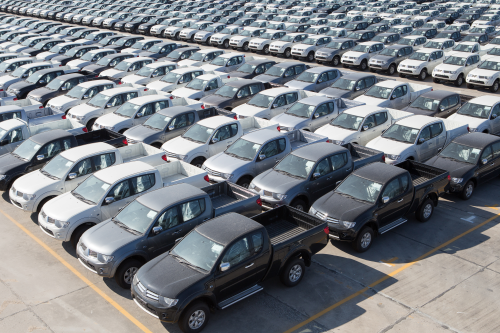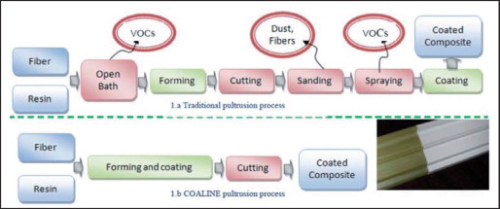


The challenge to produce lightweight vehicles is widely known, with the main advantage being the reduction in fuel consumption which directly reduces greenhouse gas emissions. In addition, automotive manufacturers have invested significant time and money in researching and developing hybrid and electric vehicles that emit fewer pollutants into the environment. This new electric vehicle architecture will need lighter materials and new production processes, which must be simpler and more flexible. The best materials to induce this change and to replace the traditional metals are composites (thermosetting resins combined with glass or carbon fibres). Composites have good mechanical properties and high corrosion resistance by maintaining low weight. In fact, the replacement of steel parts by composites could represent a reduction in weight of around 40%. Even though Glass Fibre Reinforced Plastic (GFRP) consumption in the transport industry is around 350.000 tons/year, having been introduced in different parts of vehicles, the penetration of composites in structural parts is still minimal, as they are only used in prototype cars. The extensive use of composite structures will ensure that these vehicles will be lighter than current cars.
The need for automation
The main barrier for high volume manufacturing in the automotive industry is the lack of automation in processing composites, which increases their costs. Among all processes for the production of composites, the most automated, efficient and competitive one to obtain constant section composites is the well-known pultrusion process (see Figure 2). Currently, pultrusion technology mainly consists of the forming of impregnated fibres in a die (impregnation is performed in an open bath or by injection). The die is also responsible for the curing of the resin by means of a heating system (frequently by heat resistors). Once the composite has been pulled, it is cut into the desired length.
However, several drawbacks that reduce the competitiveness of pultruded profiles in comparison to traditional materials are still waiting to be addressed. On the one hand, the process is limited by the time required for the polymerisation of the resin inside the die, which results in a low speed process. On the other hand, when a coating is needed to improve the surface of the profile, the surface of the profile must be carefully prepared in additional steps: sanding and painting processes which are expensive, highly labour-intensive and polluting. Aiming to solve this problem, the project COALINE, receiving funding from the European Union Seventh Framework Programme (FP7/2007-2013) under grant agreement No. 609149 and being coordinated by AIMPLAS, started in September 2013. The main objective of the COALINE project (Development of an innovative manufacturing process for the in-LINE COAting of pultruded composites) is the achievement of a clean one-stage in-line process, free of VOCs and small particle emissions, able to produce properly coated pultruded composite profiles by means of sensing technology, advanced mould design and microwave aided curing for improved composite/coating adhesion with reduced labour and process cost (see Figure 3). In addition, COALINE profiles will be joined to other materials by means of a primer type coating, also incorporated in-line, with on-demand bonding properties. The main target sectors of COALINE are building and automotive (parts of electric cars). The project consortium is composed of two research organisations (AIMPLAS and Fraunhofer), one University (Riga Tehnika Unniversitate), two industrial partners (Acciona and Muegge) and seven small and medium-sized enterprises (Alke, Composites Aragón, Ecoinnova, Polymec, Resoltech, Rescoll and Synthesites). The process developed in COALINE will be able to reduce considerably the required steps and emissions to obtain a high quality coated composite by integration of the forming, coating and finishing processes in one step. For that reason, affordable thermoset composite materials suitable for the substitution of traditional structural metallic parts in vehicles will be produced, which will reduce their weight, fuel consumption and emissions. Furthermore, the reduction of time in the production of the high performance coated profiles will allow the high output and continuous production that the automotive industry demands. COALINE aims to address the production of valuable coated pultruded profiles by dramatically reducing their cost (up to 35%) and the number of processing steps, significantly increasing output and improving their quality in comparison with state-of-the-art coated pultruded profiles by means of the following innovations:
- New multi-stage die design with resin and coating polymerisation separated into a multi-cavity structure.
- A microwave heating system inside the die that will reduce the polymerisation time and the energy employed to produce the composites. The MW system will be applicable independent of the type of fibres employed to produce the composites (glass or carbon).
- A new range of modified resins and gel-coats with MW susceptors to improve radiation absorption and achieve a fast curing process.
- A control system to foster the adhesion of the coating to the composite by means of a controlled curing degree in each stage of the process.
- Improvement of labour conditions by minimising the emissions of Volatile Organic Compounds (VOCs) by directly injecting the resin and the coating inside the die and avoiding post-manufacturing treatments of the composite surface.
- The development of fast curing primers to permit the employment of de-bonding on demand adhesives to foster the adhesion between the composite and metallic parts, the recycling and the maintenance of the pultruded structures.
Conclusions
This project represents one step forward in order to increase vehicle performance. Firstly, this will be due to a reduction of weight which means less energy is needed to move the vehicle, less stress is exerted on the frame, frame flexibility is improved, and higher load capacity is achieved, for example. Secondly, the project will deliver improved coating specifications which will provide benefits when operating in corrosive/critical environments. All the advantages of the composites will be achieved at a competitive cost thanks to the improvement in automation that producers of composites and the automotive industry need to launch together.
This article was published in the July/August 2014 issue of Reinforced Plastics magazine.
The digital edition of Reinforced Plastics is distributed free of charge to readers who meet our qualifying criteria. You can apply to receive your free copy by completing this short registration form.





